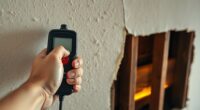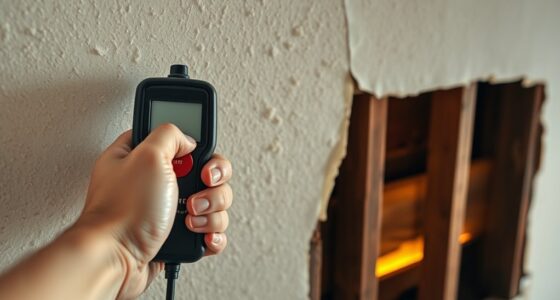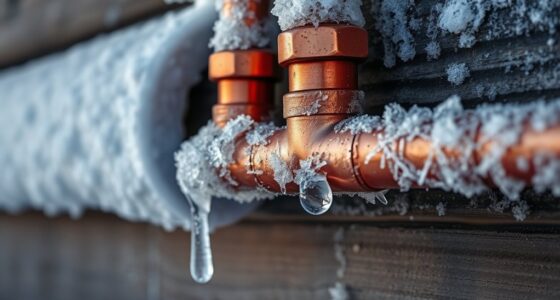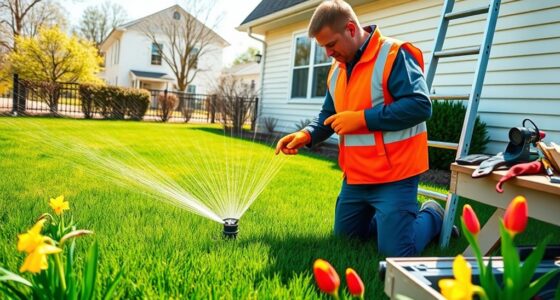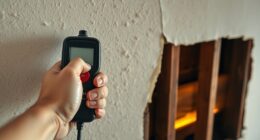To start with caulking and weatherstripping, clean all surfaces thoroughly and remove old, cracked caulk or weatherstripping. Choose the right sealant—latex for interior use or silicone for exterior—and load it into your caulking gun. Apply steady, smooth beads along gaps, then smooth the seal with a damp finger or tool. For doors and windows, install weatherstripping to create a tight seal. Keep practicing, and you’ll reveal more tips to keep your home energy-efficient.
Key Takeaways
- Choose the appropriate caulk (latex, silicone, polyurethane) based on the location and moisture exposure.
- Prepare surfaces by cleaning and removing old caulk or weatherstripping for proper adhesion.
- Apply caulk with a caulking gun in a steady, continuous motion, then smooth the bead for a clean seal.
- Install weatherstripping on moving parts like doors and windows to seal gaps when closed.
- Allow caulk to cure fully before exposing the sealed area to moisture or heavy use for maximum effectiveness.

Have you ever noticed drafts or increased energy bills despite having well-maintained windows and doors? If so, the issue might be less about the windows themselves and more about the gaps or leaks that let air sneak through. Caulking and weatherstripping are simple, cost-effective solutions you can do yourself to improve your home’s energy efficiency. Before diving in, it’s helpful to understand the different sealant types available and some installation tips to ensure your work lasts.
Gaps around windows and doors cause drafts—seal them with caulking and weatherstripping for energy savings.
When choosing a sealant type, you’ll find options like latex, silicone, and polyurethane. Latex caulk is easy to work with, clean up, and works well for interior applications where flexibility isn’t critical. Silicone sealant, on the other hand, offers superior flexibility and durability, making it ideal for exterior use and areas prone to moisture. Polyurethane provides a strong, weatherproof seal and is excellent for sealing gaps in siding or around window frames. Understanding the properties of each type helps you pick the right one for your project, ensuring a long-lasting seal that prevents drafts.
Installing caulking properly is key to its effectiveness. First, clean the surface thoroughly, removing any old caulk, dirt, or loose paint. Use a utility knife to cut away any cracked or peeling caulk or weatherstripping. When applying the sealant, load it into a caulking gun and cut the nozzle at a 45-degree angle, making sure the opening matches the width of the gap you’re sealing. Apply steady, continuous pressure on the trigger, moving smoothly along the seam. To ensure a clean finish, run a damp finger or a caulking tool along the bead to press it into the gap and smooth out any excess. Allow the sealant to cure fully before exposing it to moisture or heavy use, which can take anywhere from a few hours to a full day, depending on the product. Monitoring your payment security measures can help prevent unauthorized transactions that could compromise your financial safety.
Weatherstripping complements caulking by sealing gaps around moving parts like doors and windows. For best results, measure the gaps carefully before selecting the right weatherstripping material—whether it’s adhesive-backed foam, rubber, or vinyl. Install it by pressing or sticking the strip firmly into place, making sure it creates a tight seal when the door or window is closed. Checking and replacing weatherstripping periodically ensures your home stays sealed against drafts and keeps your energy bills in check.
Frequently Asked Questions
How Often Should I Replace Caulking and Weatherstripping?
You should replace caulking and weatherstripping every 5 to 10 years, depending on their condition. Regular maintenance tips include inspecting for cracks, gaps, or deterioration and resealing as needed. Proper sealing techniques guarantee the best insulation and energy efficiency. Keep an eye on weather changes and wear, replacing materials promptly to prevent drafts, moisture intrusion, and higher energy bills. Staying proactive helps maintain your home’s comfort and efficiency.
Can I Use Caulk or Weatherstripping Outdoors in Extreme Weather?
When facing the storm’s fury, you need materials that stand tall like a fortress. Yes, you can use caulk and weatherstripping outdoors in extreme weather, but only if they’re designed for outdoor durability and extreme weather resistance. Look for products labeled specifically for outdoor use, and verify they’re rated to withstand rain, snow, or scorching heat. This way, your home stays protected, no matter what nature throws your way.
What Are the Best Tools for Applying Caulking Accurately?
To apply caulking accurately, you need the right tools like a caulk gun, a utility knife, and a caulk smoothing tool. Focus on proper application techniques, such as steady pressure and even movement, to get a clean seal. Keep your tools well-maintained by cleaning the nozzle and replacing worn parts. This guarantees smooth application and helps you achieve professional-looking results that last.
Are There Eco-Friendly or Low-Voc Caulking Options Available?
You’ll be glad to know eco-friendly alternatives and low VOC formulations are widely available for caulking. These options reduce harmful fumes, making your DIY project safer for your family and the environment. While some worry about effectiveness, many eco-friendly caulks now match traditional ones in durability and adhesion. Choosing low VOC formulations guarantees your home stays healthier, all while you get a tidy, professional finish without compromising safety or performance.
How Do I Remove Old, Cracked Caulking Effectively?
To remove old, cracked caulking effectively, start by softening it with a caulk remover or a heat gun. Use a utility knife or caulk removal tools to carefully cut and lift the caulk. Be sure to wear safety gloves and goggles to protect yourself from debris. Follow safety precautions, work slowly, and make certain the area is well-ventilated. Once removed, clean the surface thoroughly before applying new caulk.
Conclusion
Now that you’ve mastered the fundamentals of fixing gaps with caulking and weatherstripping, you’ll confidently combat cold drafts and costly leaks. With a little practice and patience, you’ll perfect your sealing skills, saving energy and enhancing comfort. Remember, consistent care creates cozy, cavity-free spaces. So, get your tools, stay steady, and seal smartly—your home will thank you with warmth, savings, and a snug, secure sanctuary.

